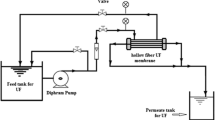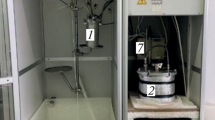Abstract
This work discusses the preparation and characterizations of glass hollow fiber membranes prepared using zeolite-5A as a starting material. Zeolite was formed into a hollow fiber configuration using the phase inversion technique. It was later sintered at high temperatures to burn off organic materials and change the zeolite into glass membrane. A preliminary study, that used thermogravimetric analysis (TGA), X-ray diffraction (XRD), and Fourier transform infrared (FTIR), confirmed that zeolite used in this study changed to glass at temperatures above 1000 °C. The glass hollow fiber membranes prepared using the phase inversion technique has three different microstructures, namely (i) sandwich-like structure that originates from inner layer, (ii) sandwich-like that originates from outer layer, and (iii) symmetric sponge like. These variations were influenced by zeolite weight loading and the flow rate of water used to form the lumen. The separation performances of the glass hollow fiber membrane were studied using the pure water permeability and the rejection test of bovine serum albumin (BSA). The glass hollow fiber membrane prepared from using 48 wt% zeolite loading and bore fluid with 9 mL min−1 flow rate has the highest BSA rejection of 85% with the water permeability of 0.7 L m−2 h−1 bar−1. The results showed that the separation performance of glass hollow fiber membranes was in the ultrafiltration range, enabled the retention of solutes with molecular sizes larger than 67 kDa such as milk proteins, endotoxin pyrogen, virus, and colloidal silica.












Similar content being viewed by others
References
Alexander S, Morrow L, Lord AM, Dunnill CW, Barron AR (2015) pH-responsive octylamine coupling modification of carboxylated aluminium oxide surfaces. J Mater Chem A 3(18):10052–10059
Boom RM, Wienk IM, van den Boomgaard T, Smolders CA (1992) Microstructures in phase inversion membranes. Part 2. The role of a polymeric additive. J Membr Sci 73(2):277–292
Colantuono A, DalVecchio S, Mascolo G, Pansini M (1996) Dilatometric behaviour of chabazite. J Therm Anal 47(1):281–289
Dell’Agli G, Ferone C, Mascolo G, Pansini M (1999) Dilatometry of Na-, K-, Ca- and NH4-clinoptilolite. Thermochim Acta 336(1–2):105–110
Enke D, Janowski F, Schwieger W (2003) Porous glasses in the 21st century—a short review. Microporous Mesoporous Mater 60(1–3):19–30
Han KN, Bernardi S, Wang L, Searles DJ (2015) Water diffusion in zeolite membranes: molecular dynamics studies on effects of water loading and thermostat. J Membr Sci 495:322–333
Hasanuzzaman M., A. Rafferty, M. Sajjia, A. G. Olabi (2016) Production and treatment of porous glass materials for advanced usage. Reference Module in Materials Science and Materials Engineering, Elsevier
Jamil SM, Othman MHD, Rahman MA, Jaafar J, Ismail AF, Li K (2015) Recent fabrication techniques for micro-tubular solid oxide fuel cell support: a review. J Eur Ceram Soc 35(1):1–22
Kingsbury BFK, Li K (2009) A morphological study of ceramic hollow fibre membranes. J Membr Sci 328(1–2):134–140
Kukizaki, M (2010) Large-scale production of alkali resistant Shirasu porous glass (SPG) membranes: influence of ZrO2 addition on crystallization and phase separation in Na2O-CaO-Al2O3-B2O3-SiO2 glasses, and alkali durability and pore morphology of the membranes. J Membr Sci 360(1–2):426–435
Kukizaki M, Goto M (2006) Size control of nanobubbles generated from Shirasu-porous-glass (SPG) membranes. J Membr Sci 281(1–2):386–396
Kukizaki M, Goto M (2007) Preparation and characterization of a new asymmetric type of Shirasu porous glass (SPG) membrane used for membrane emulsification. J Membr Sci 299(1–2):190–199
Kukizaki M, Nakashima T (2004) Acid leaching process in the preparation of porous glass membranes from phase-separated glass in the Na2O-CaO-MgO-Al2O3-B2O3-SiO2 system. Membrane 29(5):301–308
Lai YT, Sato M, Ohta S, Akamatsu K, Nakao S, Sakai Y, Ito T (2015) Preparation of uniform-sized hemoglobin-albumin microspheres as oxygen carriers by Shirasu porous glass membrane emulsification technique. Colloids Surf B Biointerfaces 127:1–7
Lee M, Wang B, Wu ZT, Li K (2015) Formation of micro-channels in ceramic membranes—spatial structure, simulation, and potential use in water treatment. J Membr Sci 483:1–14
Li Y, Chen H, Liu J, Yang W (2006) Microwave synthesis of LTA zeolite membranes without seeding. J Membr Sci 277(1–2):230–239
Liu R, Ma GH, Meng FT, Su ZG (2005) Preparation of uniform-sized PLA microcapsules by combining Shirasu porous glass membrane emulsification technique and multiple emulsion-solvent evaporation method. J Control Release 103(1):31–43
Lopes AC, Martins P, Lanceros-Mendez S (2014) Aluminosilicate and aluminosilicate based polymer composites: present status, applications and future trends. Prog Surf Sci 89(3–4):239–277
Ma GH, Nagai M, Omi S (1999) Study on preparation and morphology of uniform artificial polystyrene-poly(methyl methacrylate) composite microspheres by employing the SPG (Shirasu porous glass) membrane emulsification technique. J Colloid Interface Sci 214(2):264–282
Mohamed MH, Othman MHD, Abd Mutalib M, Rahman M, Jaafar J, Ismail AF, Mohamed Dzahir MIH (2016) Structural control of NiO-YSZ/LSCF-YSZ dual-layer hollow fiber membrane for potential syngas production. Int J Appl Ceram Technol 13(5):799–809
Paiman SH, Rahman MA, Othman MHD, Ismail AF, Jaafar J, Aziz AA (2015) Morphological study of yttria-stabilized zirconia hollow fibre membrane prepared using phase inversion/sintering technique. Ceram Int 41(10):12543–12553
Palenta T, Fuhrmann S, Greaves GN, Schwieger W, Wondraczek L (2015) Thermal collapse and hierarchy of polymorphs in a faujasite-type zeolite and its analogous melt-quenched glass. J Chem Phys 142(8):084503
Shameli K, Bin Ahmad M, Zargar M, Yunus WMZW, Ibrahim NA (2011) Fabrication of silver nanoparticles doped in the zeolite framework and antibacterial activity. Int J Nanomedicine 6:331–341
Shao J, Zhan ZY, Li JG, Wang ZB, Li K, Yan YS (2014) Zeolite NaA membranes supported on alumina hollow fibers: effect of support resistances on pervaporation performance. J Membr Sci 451:10–17
Sukas S, Tiggelaar RM, Desmet G, Gardeniers JGE (2013) Fabrication of integrated porous glass for microfluidic applications. Lab Chip 13(15):3061–3069
Tan XY, Li K (2011) Inorganic hollow fibre membranes in catalytic processing. Curr Opin Chem Eng 1(1):69–76
Tavolaro A, Drioli E (1999) Zeolite membranes. Adv Mater 11(12):975–996
Vladisavljevic GT, Schubert H (2002) Preparation and analysis of oil-in-water emulsions with a narrow droplet size distribution using Shirasu-porous-glass (SPG) membranes. Desalination 144(1–3):167–172
Wang YJ, Tang Y, Dong AG, Wang XD, Ren N, Shan W, Gao Z (2002) Self-supporting porous zeolite membranes with sponge-like architecture and zeolitic microtubes. Adv Mater 14(13–14):994–997
Wei CC, Chen OY, Liu Y, Li K (2008) Ceramic asymmetric hollow fibre membranes-one step fabrication process. J Membr Sci 320(1–2):191–197
Wondraczek L, Gao GJ, Moncke D, Selvam T, Kuhnt A, Schwieger W, Palles D, Kamitsos EI (2013) Thermal collapse of SAPO-34 molecular sieve towards a perfect glass. J Non-Cryst Solids 360:36–40
Xiao M, Hu XJ, Gong Y, Gao D, Zhang P, Liu QX, Liu Y, Wang MC (2015) Solid transformation synthesis of zeolites from fly ash. RSC Adv 5(122):100743–100749
Zhang C, Zhang K, Xu L, Labreche Y, Kraftschik B, Koros WJ (2014) Highly scalable ZIF-based mixed-matrix hollow fiber membranes for advanced hydrocarbon separations. AICHE J 60(7):2625–2635
Acknowledgements
The authors gratefully acknowledge financial support from various parties, namely Higher Institution Centre of Excellence (HICoE) Research Grant (R. J090301.7846.4J178) and Universiti Teknologi Malaysia (UTM) through the Research University Grants (Q.J130000.2446.03G37, Q.J130000.2546.12H22). Appreciation also goes to UTM Research Management Centre for both financial and technical support.
Author information
Authors and Affiliations
Corresponding author
Additional information
Responsible editor: Philippe Garrigues
Rights and permissions
About this article
Cite this article
Makhtar, S.N.N.M., Rahman, M.A., Ismail, A.F. et al. Preparation and characterization of glass hollow fiber membrane for water purification applications. Environ Sci Pollut Res 24, 15918–15928 (2017). https://doi.org/10.1007/s11356-017-9405-7
Received:
Accepted:
Published:
Issue Date:
DOI: https://doi.org/10.1007/s11356-017-9405-7




